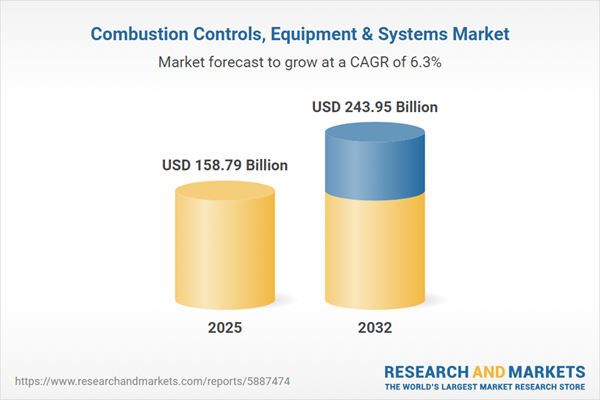Speak directly to the analyst to clarify any post sales queries you may have.
Senior executives overseeing combustion controls, equipment, and systems must navigate rapid shifts in technologies, evolving sustainability mandates, and increasing operational expectations. Success in this dynamic sector demands clarity on the trends and challenges impacting strategic decisions, so leaders can stay resilient and competitive within a changing landscape.
Market Snapshot: Combustion Controls, Equipment & Systems Market
The global combustion controls, equipment, and systems market stands at USD 149.32 billion, with forecasts projecting growth to USD 158.79 billion in the upcoming year and a long-term outlook reaching USD 243.95 billion by 2032. This market maintains a solid compound annual growth rate of 6.32%, propelled by accelerated digital transformation, rising regulatory oversight, and robust safety and compliance requirements. Both developed and emerging economies are driving modernization projects, emphasizing advanced technology integration and adherence to more stringent emissions and operational standards. These trends are redefining industry practices, setting the stage for heightened competition and increased focus on sustainable operations across all regions.
Scope & Segmentation of the Combustion Controls, Equipment, and Systems Market
This report provides senior leaders a comprehensive understanding of the market’s evolving structure, vital for effective strategy formation and risk management. Segmentation highlights include:
- Product Types: Industrial essentials such as fire-tube and water-tube boilers, diffusion and premix burners, combustion analyzers, integrated furnace controls, flame safeguards, and pressure switches—which all support enhanced efficiency and operational reliability in both commercial and manufacturing settings.
- Fuel Types: Biomass fuels (including wood chips and agricultural byproducts), coal, biogas, natural gas, and oil-based options—each facilitating the ongoing energy transition and helping organizations comply with diverse sustainability regulations.
- End Uses: Multiple industries like hospitality, retail, chemical processing, metals, petrochemical, power generation, industrial steam turbines, and residential applications—each segment facing unique requirements tied to safety, regulatory alignment, and performance consistency.
- Installation Types: New installations, aftermarket system upgrades, and retrofits—reflecting strategic decisions for modernization, infrastructure adaptation, and extended asset life cycles as companies prioritize compliance and competitiveness.
- Regions: Americas, Europe, Middle East, Africa, and Asia-Pacific—where local policies, adoption of new technology, and market incentives directly influence compliance strategies and go-to-market approaches.
- Leading Companies: Honeywell International Inc., Emerson Electric Co., Siemens AG, Schneider Electric SE, ABB Ltd, Mitsubishi Electric Corporation, Yokogawa Electric Corporation, Johnson Controls International plc, Robert Bosch GmbH, and Danfoss A/S, all contributing to industry benchmarks and technological progress worldwide.
Key Takeaways for Senior Decision-Makers
- Digital sensors and automation improve the reliability of combustion equipment, enabling predictive maintenance and reducing unplanned downtime across operations.
- Leveraging modular and environmentally friendly technologies allows organizations to meet evolving environmental regulations while supporting long-term sustainability goals across jurisdictions.
- Remote-access and diagnostic-enabled controls offer improved operational visibility, enabling continuous monitoring and faster resolution of issues to minimize costly disruptions.
- Strategic adaptation to local infrastructure and regulatory frameworks is crucial for maintaining compliance and addressing region-specific operational challenges effectively.
- Proactive partnerships and participation in the development of industry standards equip organizations to adjust swiftly to shifting policy landscapes and unexpected market trends.
Tariff Impact on Supply Chain and Cost Structures
Anticipated changes in U.S. tariff policy are leading companies within the combustion controls and equipment sector to reassess global sourcing and distribution strategies. A focus on strengthening regional and domestic supply chains aims to boost procurement reliability and ensure greater cost certainty. This shift influences not only immediate operational tactics but also shapes long-term investment decisions, directly impacting future competitiveness and resilience to market volatility.
Methodology & Data Sources
This report employs a robust multi-phase research approach, integrating regulatory reviews, advanced market modeling, direct consultations with industry subject-matter experts, and onsite field verification. Contributions from senior executives ensure the findings offer actionable guidance for leadership teams across the combustion controls ecosystem.
Why This Report Matters
- Equips executive teams with targeted market intelligence to fine-tune investments and respond confidently to ongoing shifts in sustainability, digitalization, and compliance within the combustion controls, equipment, and systems market.
- Delivers actionable insights for benchmarking performance, mitigating risks, and realigning supply chains as regulatory and technology landscapes continue to evolve.
Conclusion
This analysis provides senior leaders with essential insights to adapt to industry transformation, develop resilient operational strategies, and support sustained growth in an environment defined by technological change and regulatory complexity.
Additional Product Information:
- Purchase of this report includes 1 year online access with quarterly updates.
- This report can be updated on request. Please contact our Customer Experience team using the Ask a Question widget on our website.
Table of Contents
3. Executive Summary
4. Market Overview
7. Cumulative Impact of Artificial Intelligence 2025
Companies Mentioned
The companies profiled in this Combustion Controls, Equipment & Systems market report include:- Honeywell International Inc.
- Emerson Electric Co.
- Siemens AG
- Schneider Electric SE
- ABB Ltd
- Mitsubishi Electric Corporation
- Yokogawa Electric Corporation
- Johnson Controls International plc
- Robert Bosch GmbH
- Danfoss A/S
Table Information
| Report Attribute | Details |
|---|---|
| No. of Pages | 181 |
| Published | October 2025 |
| Forecast Period | 2025 - 2032 |
| Estimated Market Value ( USD | $ 158.79 Billion |
| Forecasted Market Value ( USD | $ 243.95 Billion |
| Compound Annual Growth Rate | 6.3% |
| Regions Covered | Global |
| No. of Companies Mentioned | 11 |









